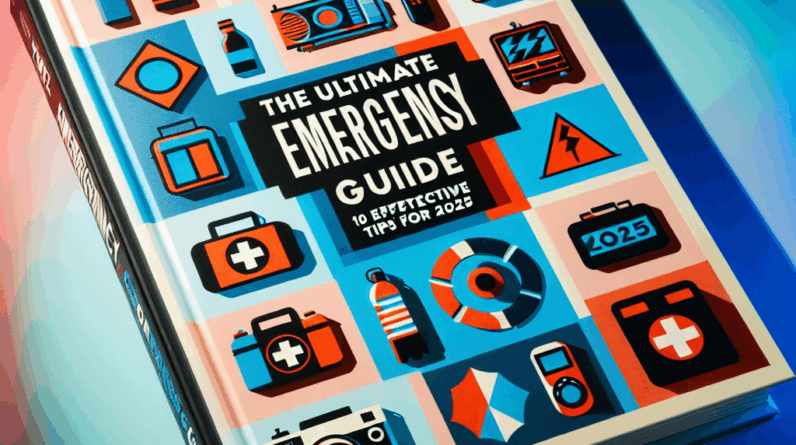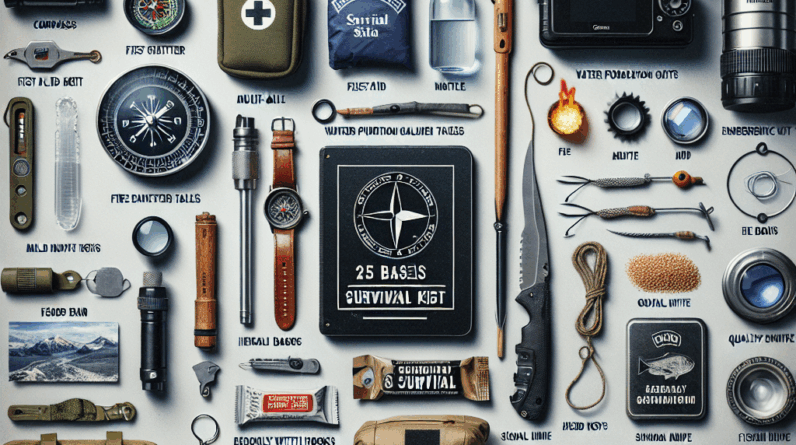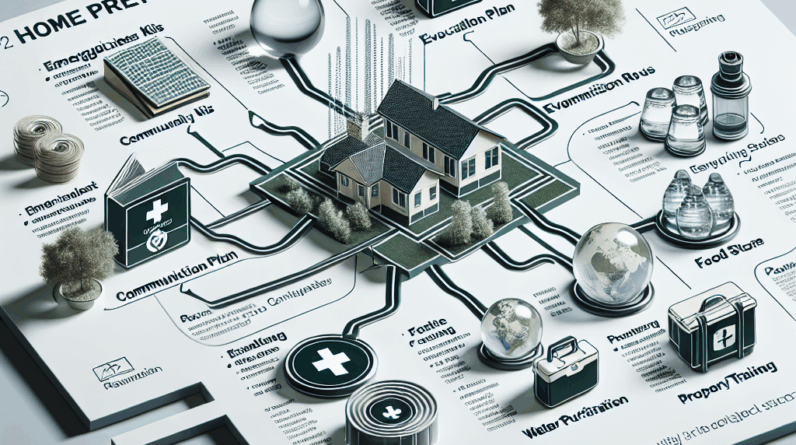
As we approach 2025, the importance of emergency preparedness cannot be overstated. From natural disasters to unforeseen disruptions, having a robust emergency readiness guide is crucial for ensuring your safety and maintaining peace of mind. This article explores 10 key strategies to enhance your preparedness for the coming year and beyond.
Build a Comprehensive Emergency Kit
A fundamental element of emergency preparedness is the creation of a well-equipped emergency kit. Experts suggest including a minimum of three days’ worth of food and water per person, prioritizing non-perishable items such as canned goods, energy bars, and bottled water. It’s also advised to refresh these supplies every six months to ensure they remain fresh and safe. Your emergency kit should also contain essential items like flashlights, batteries, a battery-powered radio, and a basic first aid kit. Depending on your locale, tailor your kit to include appropriate items, such as waterproof gear for flood-prone areas or face masks and sanitizers for urban environments facing ongoing health issues in 2025.
Store and Maintain Your Emergency Kit Effectively
Choose an easily accessible location in your home for your emergency kit, such as a hallway closet or garage, and clearly label it. Consider having additional smaller kits in your car and workplace. Utilize durable containers for storage to protect against weather and potential tampering. Regular checks and maintenance of your kit ensure that expired or depleted items are promptly replaced, keeping the kit ready at all times.
Real-Life Benefits of a Prepared Emergency Kit
Families with adequately prepared emergency kits have experienced significantly less stress during natural disasters like hurricanes. For instance, during Hurricane Ida in 2024, those with pre-prepared kits could focus more on safe evacuation rather than scrambling for basic necessities.
Develop a Detailed Family Emergency Plan
A critical component of any emergency readiness guide is having a detailed emergency plan for your family. This plan should encompass contact information for all family members and designated meeting points both within and outside your neighborhood. Embrace digital communication tools and ensure all family members are familiar with them, especially if traditional communication networks fail. Regular drills and updates of the plan help in refining the response to various potential emergencies.
Practice and Update Emergency Plans Regularly
Make it a routine to practice emergency scenarios with your family, updating your plans annually or following significant life changes. Utilize technology like shared digital calendars or emergency planning apps to keep everyone informed and prepared for any situation.
Stay Proactive with Emergency Alerts
Keeping abreast of emergency alerts is essential. Sign up for local government notifications and ensure your mobile devices are set up to receive these alerts. Install applications that provide real-time updates during severe weather or other emergencies. Additionally, stay informed through reliable sources like the National Weather Service or local emergency management agencies to make timely decisions during crises.
Importance of Monitoring Updates and Reliable Information
Beyond signing up for official alerts, it’s crucial to follow trusted news sources and local authority updates. In 2025, many organizations are expected to enhance their forecasting and information dissemination through advanced technologies like AI and machine learning, aiding in quicker and more effective decision-making during emergencies.
The Impact of Timely and Accurate Information
Residents who prioritize staying informed, especially in regions prone to natural disasters like wildfires, have been able to evacuate safely and promptly, often avoiding the worst impacts. This underscores the importance of having effective alert systems as part of your emergency readiness strategy.
Learn Essential First Aid and CPR
Acquiring basic first aid and CPR skills is vital, with many communities offering certified courses through local centers or online. These skills are crucial for managing injuries and potentially saving lives until professional medical help is available. Keeping a well-stocked first aid kit and sharing your knowledge with others enhances the safety and preparedness of your community.
First Aid Skills in Action
Regular practice of first aid and CPR ensures readiness when faced with medical emergencies. Equip your emergency kit with comprehensive first aid supplies and consider including digital resources for quick reference. Community engagement through sharing these vital skills can significantly enhance collective emergency response capabilities.
Secure Your Home Against Potential Disasters
Preventive measures to fortify your home include securing heavy furniture, installing storm shutters, and maintaining the structural integrity of your property. Consider investments in seismic retrofits or flood barriers if you reside in high-risk areas. Regular maintenance and updates to your home’s safety features can prevent significant damage during disasters, reduce insurance costs, and facilitate quicker recovery.
The Value of Home Safety Investments
Homes that have invested in preventive safety measures, especially in disaster-prone areas, have shown resilience during events like hurricanes, with significantly reduced damage. These proactive steps are integral to an effective emergency readiness plan.
Develop Robust Digital Emergency Backup Plans
In today’s digital era, it’s imperative to secure important documents such as IDs, insurance policies, and medical records in digital formats. Store these in encrypted cloud services or secure external drives to ensure they are accessible during emergencies. Familiarize yourself with the process of retrieving these documents and regularly back up your data to safeguard against loss.
Utilize Emergency Apps and Maintain Digital Readiness
Incorporate disaster management apps that store essential information and provide updates during emergencies. Share access with trusted individuals to facilitate coordinated response efforts. The adoption of digital tools in your emergency readiness plan is crucial for maintaining resilience in the face of evolving technological landscapes in 2025.
Practice Regular Emergency Drills
Regular drills help ensure that your emergency plans are effective and can be smoothly executed when necessary. Simulate various scenarios to test your preparedness and make adjustments based on the outcomes. Engaging all family members in these drills builds a cohesive response capability across all age groups.
Understand and Utilize Local Emergency Resources
Familiarize yourself with local emergency services such as shelters, medical facilities, and community centers. Building connections with neighbors and local groups enhances your support network, which can prove invaluable during emergencies. Keep updated contact lists and resource directories both physically and digitally to ensure quick access when needed.
Keep Calm and Make Informed Decisions During Emergencies
Maintaining composure during emergencies enables more effective decision-making. Practice stress-management techniques like mindfulness to help control panic and anxiety. Encourage clear communication and support among family members to foster a collaborative approach to crisis management.
Review and Continuously Update Your Emergency Readness Guide
The dynamic nature of threats necessitates regular updates to your emergency readiness guide. Incorporate feedback from drills and actual emergencies to refine your strategies. Utilize modern tools to keep your plans current and ensure all family members are consistently informed and prepared.
Conclusion
A robust emergency readiness guide is indispensable for navigating the challenges of 2025. By implementing these 10 essential tips, you can significantly enhance your preparedness and security. Remember, effective preparedness is an ongoing process that involves continual learning, practice, and improvement. Prioritize your safety by staying alert, informed, and ready to adapt to any situation.
Frequently Asked Questions
1. What should be included in an emergency readiness guide?
Your guide should encompass a comprehensive emergency kit, detailed communication plans, up-to-date contact information, essential documents, and specific measures for home safety. Regular practice and updates are crucial to ensure effectiveness.
2. How often should I review my emergency readiness plan?
Review and update your plan at least annually, or after significant life events or emergencies. This helps maintain its relevance and effectiveness in an evolving environment.
3. Why is an emergency readiness guide important for families?
A well-prepared emergency guide facilitates quick and efficient response during emergencies, minimizing confusion and enhancing safety for all family members.
4. How can I stay informed about emergency alerts in 2025?
Register for local notifications, utilize reliable emergency alert apps, and keep your communication devices updated. Engaging with community programs and resources also strengthens your overall preparedness.





